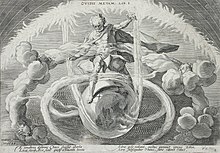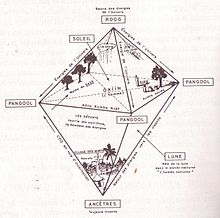
A | B | C | D | E | F | G | H | CH | I | J | K | L | M | N | O | P | Q | R | S | T | U | V | W | X | Y | Z | 0 | 1 | 2 | 3 | 4 | 5 | 6 | 7 | 8 | 9

Cosmogony is any model concerning the origin of the cosmos or the universe.[1][2][3]
Overview
Scientific theories

In astronomy, cosmogony refers to the study of the origin of particular astrophysical objects or systems, and is most commonly used in reference to the origin of the universe, the Solar System, or the Earth–Moon system.[1][2] The prevalent cosmological model of the early development of the universe is the Big Bang theory.[4]
Sean M. Carroll, who specializes in theoretical cosmology and field theory, explains two competing explanations for the origins of the singularity, which is the center of a space in which a characteristic is limitless[5] (one example is the singularity of a black hole, where gravity is the characteristic that becomes limitless — infinite).
It is generally thought that the universe began at a point of singularity, but among Modern Cosmologists and Physicists, a singularity usually represents a lack of understanding, and in the case of Cosmology/Cosmogony, requires a theory of quantum gravity to understand. When the universe started to expand, what is colloquially known as the Big Bang occurred, which evidently began the universe. The other explanation, held by proponents such as Stephen Hawking, asserts that time did not exist when it emerged along with the universe. This assertion implies that the universe does not have a beginning, as time did not exist "prior" to the universe. Hence, it is unclear whether properties such as space or time emerged with the singularity and the known universe.[5][6][clarification needed]
Despite the research, there is currently no theoretical model that explains the earliest moments of the universe's existence (during the Planck epoch) due to a lack of a testable theory of quantum gravity. Nevertheless, researchers of string theory, its extensions (such as M-theory), and of loop quantum cosmology, like Barton Zwiebach and Washington Taylor, have proposed solutions to assist in the explanation of the universe's earliest moments.[7] Cosmogonists have only tentative theories for the early stages of the universe and its beginning. The proposed theoretical scenarios include string theory, M-theory, the Hartle–Hawking initial state, emergent Universe, string landscape, cosmic inflation, the Big Bang, and the ekpyrotic universe. Some of these proposed scenarios, like the string theory, are compatible, whereas others are not.[8]
Mythology

In mythology, creation or cosmogonic myths are narratives describing the beginning of the universe or cosmos.
Some methods of the creation of the universe in mythology include:
- the will or action of a supreme being or beings,
- the process of metamorphosis,
- the copulation of female and male deities,
- from chaos,
- or via a cosmic egg.[9]
Creation myths may be etiological, attempting to provide explanations for the origin of the universe. For instance, Eridu Genesis, the oldest known creation myth, contains an account of the creation of the world in which the universe was created out of a primeval sea (Abzu).[10][11] Creation myths vary, but they may share similar deities or symbols. For instance, the ruler of the gods in Greek mythology, Zeus, is similar to the ruler of the gods in Roman mythology, Jupiter.[12] Another example is the ruler of the gods in Tagalog mythology, Bathala, who is similar to various rulers of certain pantheons within Philippine mythology such as the Bisaya's Kaptan.[13][14]

Compared with cosmology
In the humanities, the distinction between cosmogony and cosmology is blurred. For example, in theology, the cosmological argument for the existence of God (pre-cosmic cosmogonic bearer of personhood) is an appeal to ideas concerning the origin of the universe and is thus cosmogonical.[15] Some religious cosmogonies have an impersonal first cause (for example Taoism).[16]
However, in astronomy, cosmogony can be distinguished from cosmology, which studies the universe and its existence, but does not necessarily inquire into its origins. There is therefore a scientific distinction between cosmological and cosmogonical ideas. Physical cosmology is the science that attempts to explain all observations relevant to the development and characteristics of the universe on its largest scale. Some questions regarding the behaviour of the universe have been described by some physicists and cosmologists as being extra-scientific or metaphysical. Attempted solutions to such questions may include the extrapolation of scientific theories to untested regimes (such as the Planck epoch), or the inclusion of philosophical or religious ideas.[6][15][4]
See also
- Anthropic principle – Hypothesis about sapient life and the universe
- Cosmography – Science that maps the universe
- Chronology of the universe – History and future of the universe
- Ultimate fate of the universe – Theories about the end of the universe
- Why there is anything at all
References
- ^ a b Ridpath, Ian (2012). A Dictionary of Astronomy. Oxford University Press.
- ^ a b Woolfson, Michael Mark (1979). "Cosmogony Today". Quarterly Journal of the Royal Astronomical Society. 20 (2): 97–114. Bibcode:1979QJRAS..20...97W.
- ^ Staff. "γίγνομαι – come into a new state of being". Tufts University. Retrieved 17 September 2014.
- ^ a b Wollack, Edward J. (10 December 2010). "Cosmology: The Study of the Universe". Universe 101: Big Bang Theory. NASA. Archived from the original on 14 May 2011. Retrieved 27 April 2011.
- ^ a b Carroll, Sean (28 April 2012). "A Universe from Nothing?". Science for the Curious. Archived from the original on 10 May 2016. Retrieved 22 April 2019.
- ^ a b Carroll, Sean; Carroll, Sean M. (2003). Spacetime and Geometry: An Introduction to General Relativity. Pearson.
- ^ "String Theory/Holography/Gravity". Center for Theoretical Physics. Retrieved 20 April 2019.
- ^ Becker, Katrin; Becker, Melanie; Schwartz, John (2007). String Theory and M-Theory. Cambridge, UK: Cambridge University Press.
- ^ Long, Charles. "Creation Myth". Encyclopedia Britannica. Retrieved 20 April 2019.
- ^ "Eridu Genesis Mesopotamia Epic". Encyclopaedia Britannica. Encyclopaedia Britannica, Inc. 20 July 1998. Retrieved 30 April 2019.
- ^ Morris, Charles (1897). "The Primeval Ocean". Proceedings of the Academy of Natural Sciences of Philadelphia. 49: 12–17. JSTOR 4062253.
- ^ Thury, Eva; Devinney, Margaret (2017). Introduction to Mythology Contemporary Approaches to Classical and World Myths, 4th ed. Madison Avenue, New York: Oxford University Press. pp. 4, 187.
- ^ Garverza, J. K. (2014). The Myths of the Philippines. University of the Philippines.
- ^ Jocano, F. L. (1969). Philippine Mythology. Quezon City: Capitol Publishing House Inc.
- ^ a b Smeenk, Christopher; Ellis, George (Winter 2017). "Philosophy of Cosmology". Stanford Encyclopedia of Philosophy. Retrieved 30 April 2019.
- ^ "BBC - Religions - Taoism: Gods and spirits". www.bbc.co.uk. BBC.
External links
 Media related to Cosmogony at Wikimedia Commons
Media related to Cosmogony at Wikimedia Commons
Text je dostupný za podmienok Creative Commons Attribution/Share-Alike License 3.0 Unported; prípadne za ďalších podmienok. Podrobnejšie informácie nájdete na stránke Podmienky použitia.
Abomey
Adjassou-Linguetor
Adya Houn'tò
African-American religion
African diaspora in the Americas
African diaspora religions
African divination
African philosophy
Agassou
Agwé
Aja people
Akan religion
Alfred Burdon Ellis
Anaisa Pye
Androgyny
Angel
Arará religion
Autoritní kontrola
Ayida-Weddo
Ayizan
Azaka-Tonnerre
Baluba mythology
Bandiagara Escarpment
Bantu religion
Baron Criminel
Baron Samedi
Belie Belcan
Benin
Benin City
Bossou Ashadeh
Boum'ba Maza
Bugid Y Aiba
Bushongo mythology
Bwiti
Candomblé
Candomblé Jejé
Captain Debas
Christianity
Clermeil
Colonisation of Africa
Cosmogony
Creator deity
Cuban Vodú
Dahomean religion
Dahomey
Damballa
Dan Petro
Diable Tonnere
Diejuste
Digital object identifier
Dinclinsin
Dingir (časopis)
Dini Ya Msambwa
Dinka religion
Divination
Dogon religion
Doi (identifier)
Dominican Vudú
Domorodá náboženství
Eclecticism
Efik mythology
Erzulie
Ewe language
Ewe people
Fatick
Fetishism
File:Akodessawa Fetish Market 2005.jpg
File:Akodessawa Fetish Market 2008.jpg
File:Akodessawa Fetish Market 2016.jpg
File:Booth at Akodessawa Fetish Market 2008.jpg
File:Booth at Akodessawa Fetish Market 2016.jpg
File:Brooklyn Museum 1989.51.39 Nommo Figure with Raised Arms.jpg
File:COLLECTIE TROPENMUSEUM Houten masker TMnr 6372-2.jpg
File:Preparation of a bat at Akodessawa Fetish Market for Voodoo rituals.jpg
File:Skulls at Akodessawa Fetish Market 2008.jpg
File:Skulls at Akodessawa Fetish Market 2016.jpg
File:Voodo-altar.jpg
File:Voodo-fetischmarkt-Lomé.jpg
File:Voodoo.jpg
Filomez
Fon language
Fon people
Gemeinsame Normdatei
Ghana
Gran Maître
Gris-gris (talisman)
Guédé-Double
Guédé-Linto
Guede
Guede L'Orage
Guede Nibo
Gun language
Haiti
Haitian mythology
Haitian Vodou
Haitian Vodou art
Hausa animism
Help:Authority control
Help:CS1 errors#periodical ignored
Help:IPA
Heviosso
High priestess
Hogon
Hoodoo (folk magic)
Hoodoo (spirituality)
Houngan
Ifá
Ifẹ
Igbo-Ukwu
Intercession of saints
International Standard Book Number
Internet Archive
ISBN (identifier)
Islam
ISO 3166-2:BJ
ISSN (identifier)
Jorubové
Joseph Danger
JSTOR (identifier)
Juju
Kabiye
Kalfu
Kanem–Bornu Empire
Kingdom of Sine
Kongo religion
Kushite religion
L’Aube Nouvelle
Legba
Library of Congress Control Number
LIBRIS
List of African mythological figures
Loa
Lomé
Lotuko mythology
Louisiana Voodoo
Lozi mythology
Lugbara mythology
Maîtresse Délai
Maîtresse Hounon'gon
Maasai mythology
Mademoiselle Charlotte
Maman Brigitte
Mambo (Vodou)
Marassa Jumeaux
Marinette (loa)
Mawu
Mbuti mythology
Mombu
Mounanchou
Mount Hombori
Multiple religious belonging
Národní knihovna České republiky
Národní knihovna Izraele
Nana Buluku
Nasal vowel
Ndut initiation rite
Nebeská cirkev Kristova
New World
Nigeria
Nommo
Nri-Igbo
Nsukka
Odinala
Ogun
Okuyi
Ondřej Havelka (cestovatel)
Ouidah
Oyo, Oyo
Papa Legba
Persecution of traditional African religions
Phallus
Pie (loa)
Point of Sangomar
Polytematický strukturovaný heslář
Portal:Traditional African religion
Portal:Traditional African religions
Porto Novo
Priestly caste
Q177764#identifiers
Q177764#identifiers|Editovat na Wikidatech
Queen mothers in Africa
Religious cosmology
Religious persecution#Persecution of Dogons
Religious persecution#Persecution of Serers
Roman Catholic
S2CID (identifier)
Saltigue
Sangha, Mali
Sangha Ogol Leye
Santería
San religion
Serer religion
Shango
Simbi
Sine River
Sirius#Dogon
Sirius#Serer spirituality
Sobo (deity)
Somb
Soubor:Vodun statue in Benin.jpg
Soubor:Voodo-altar.jpg
Sousson-Pannan
Speciální:Zdroje knih/978-80-87580-24-0
Syncretic religion
Syncretism
Tambor de Mina
Tattaguine
Template:Cite book
Template:Traditional African religions
Template:Voodoo sidebar
Template talk:Traditional African religions
Template talk:Voodoo sidebar
The Journal of Negro History/Volume 7/Number 1/Slave Society on the Southern Plantation
Ti Jean Petro
Ti Jean Quinto
Ti Malice and Bouki
Togo
Tone (linguistics)
Traditional African religions
Traditional African religion and other religions
Trinidadian Vodunu
Tukar
Tumbuka mythology
Vúdú
Veneration of the dead
Veve
Vlajka Beninu
Vodun
Vodun art
Voodoo (disambiguation)
Waaqeffanna
Wayback Machine
West Africa
West African mythology
Wikimedia Commons
Wikipedia:Contents/Portals
Winti
Witchcraft
Witch doctor
Yaboyabo
Yoruba religion
Youga Dogorou
Zangbeto
Zulu traditional religion
Text je dostupný za podmienok Creative
Commons Attribution/Share-Alike License 3.0 Unported; prípadne za ďalších
podmienok.
Podrobnejšie informácie nájdete na stránke Podmienky
použitia.
www.astronomia.sk | www.biologia.sk | www.botanika.sk | www.dejiny.sk | www.economy.sk | www.elektrotechnika.sk | www.estetika.sk | www.farmakologia.sk | www.filozofia.sk | Fyzika | www.futurologia.sk | www.genetika.sk | www.chemia.sk | www.lingvistika.sk | www.politologia.sk | www.psychologia.sk | www.sexuologia.sk | www.sociologia.sk | www.veda.sk I www.zoologia.sk
